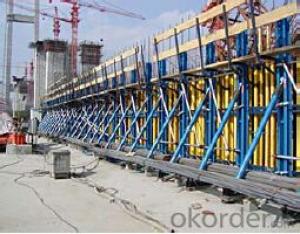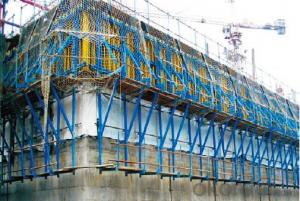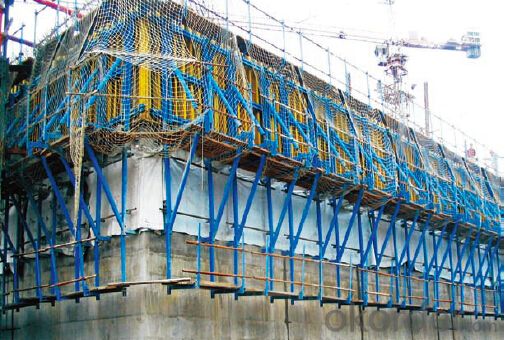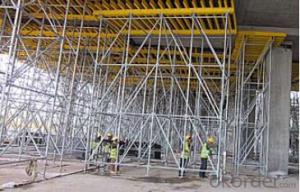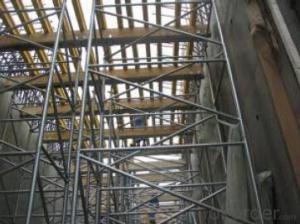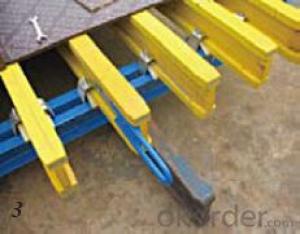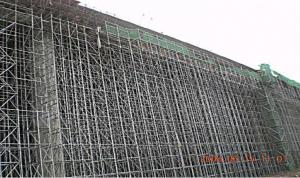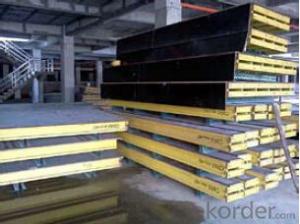Single Side Climbing Bracket for formwork and scaffolding systems
- Loading Port:
- Tianjin
- Payment Terms:
- TT OR LC
- Min Order Qty:
- 50 m²
- Supply Capability:
- 1000 m²/month
OKorder Service Pledge
OKorder Financial Service
You Might Also Like
Single-side Climbing Bracket SCB180:
With CNBM SCB 180 climbing systems, the loads from the fresh concrete pressure are
transferred through the brackets by means of V-strongbacks and compression braces into the
scaffold anchors.
Typical applications for the SCB 180 are dams, locks, cooling towers, pier heads, tunnels, and
bank vaults.
The formwork is simply tilted backwards when striking takes place. The 1.80 m wide bracket
requires only a minimum of space.
Characteristics:
◆ Economical and safe anchoring
The M30/D20 climbing cones have been designed especially for single-sided concreting using
SCB180 in dam construction, and to allow the transfer of high tensile and shear forces into the still
fresh, unreinforced concrete. Without wall-through tie-rods, finished concrete is perfect.
◆ Stable and cost-effective for high loads
generous bracket spacings allow large-area formwork units with optimal utilization of the bearing
capacity. This leads to extremely economical solutions.
◆ Simple and flexible planning
With SCB180 single-sided climbing formwork, circular structures can also be concreted without
undergoing any large planning process. Even use on inclined walls is feasible without any special
measures because additional concrete loads or lifting forces can be safely transferred into the
structure.

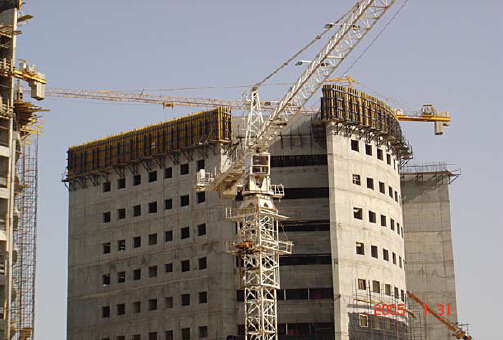
- Q: How does steel formwork handle concrete vibration during pouring?
- Steel formwork is designed to withstand the forces and pressures generated during concrete pouring and vibration. It provides a rigid and stable structure that can effectively handle the vibrations caused by the pouring process. The steel formwork is securely fixed in place, ensuring that it remains steady and does not deform or collapse under the impact of concrete vibration. Additionally, the steel material used in formwork construction has high strength and durability, allowing it to withstand the mechanical stress and vibrations induced by the pouring process without compromising its integrity.
- Q: Can steel formwork be used for precast concrete arches?
- Precast concrete arches can indeed utilize steel formwork. This material, known for its versatility and durability, proves highly capable of constructing intricate shapes and structures, including arches. During the casting process, steel formwork offers exceptional support and stability, ensuring the precise and accurate formation of arches. Moreover, steel formwork easily adapts to various arch designs and dimensions, thanks to its customizable nature. Its strength and rigidity further enable it to withstand the pressure and weight of the concrete during the curing process. Consequently, steel formwork emerges as the preferred choice for constructing precast concrete arches due to its flexibility, strength, and reliability.
- Q: Is steel formwork more durable than other types of formwork?
- Yes, steel formwork is generally considered more durable than other types of formwork. Steel has high strength and can withstand heavy loads, making it ideal for construction projects that require repetitive use and long-term durability. Additionally, steel formwork is resistant to warping, shrinking, and moisture damage, which further enhances its durability compared to other formwork materials such as wood or aluminum.
- Q: How does steel formwork affect the overall cost of concrete construction?
- The overall cost of concrete construction can be greatly impacted by the use of steel formwork. Although the initial investment in steel formwork may be more expensive than traditional wood formwork, the long-term benefits and cost savings outweigh this initial expense. One of the key advantages of steel formwork is its durability and ability to be used multiple times. Unlike wood formwork, steel formwork can be reused, which reduces the need for frequent replacements and lowers material costs. Additionally, steel formwork is resistant to warping, shrinking, and swelling, ensuring that the concrete structure maintains its intended shape and dimensions. This saves both time and money by eliminating the need for rework and adjustments. The strength and stability of steel formwork also contribute to cost savings. It can withstand higher concrete pressures, allowing for the construction of taller and more complex structures without the need for extra reinforcements or additional support systems. This decreases the amount of materials required and minimizes labor costs. Moreover, steel formwork provides a smooth and even surface finish, reducing the need for additional surface treatments or finishes. This not only saves costs on materials but also speeds up construction time by eliminating the need for extensive surface preparation. Another cost-saving aspect is the ease of assembly and disassembly associated with steel formwork. The efficient design and standardized components of steel formwork make it quick and easy to install and dismantle, reducing labor costs and improving overall productivity. In summary, even though steel formwork may have a higher initial cost, its durability, reusability, strength, stability, and ease of use can lead to significant cost savings in terms of material, labor, and time. The efficiency and longevity of steel formwork make it a cost-effective choice for concrete construction projects.
- Q: What are the common types of steel used for formwork?
- The common types of steel used for formwork can vary depending on the specific application and requirements. However, there are a few types of steel that are commonly used in formwork construction. 1. Mild Steel: This is the most commonly used type of steel for formwork. It is affordable, readily available, and easy to work with. Mild steel has a low carbon content, making it relatively soft and easy to bend or shape. However, it may not be suitable for heavy-duty or high-stress applications. 2. High Tensile Steel: High tensile steel, also known as high-strength steel, is a stronger and more durable option compared to mild steel. It contains alloys that increase its tensile strength, making it ideal for use in heavy-duty formwork applications where higher loads or stresses are expected. High tensile steel is more expensive than mild steel but offers enhanced structural integrity. 3. Stainless Steel: Stainless steel is often used in formwork applications where corrosion resistance is crucial. It contains a high percentage of chromium, which forms a protective layer on the surface, preventing rust and corrosion. Stainless steel is commonly used in marine or coastal construction projects, as well as in areas with high humidity or chemical exposure. 4. Reinforcing Steel: Reinforcing steel, also known as rebar, is commonly used in reinforced concrete formwork. It consists of steel bars or mesh that are embedded within the concrete to provide additional strength and stability. Reinforcing steel is typically made of carbon steel, but stainless steel rebar is also available for applications that require corrosion resistance. It is important to consider factors such as the load requirements, environmental conditions, and budget constraints when selecting the appropriate type of steel for formwork. Consulting with a structural engineer or construction professional can help ensure the right steel type is chosen for the specific project.
- Q: How does steel formwork handle formwork stripping time?
- Steel formwork is known for its durability and strength, which allows for efficient and quick formwork stripping. Unlike other materials like wood or plastic, steel formwork does not deform or warp under pressure, ensuring that it can be removed easily and without any damage to the concrete structure. Additionally, steel formwork systems are designed with quick-release mechanisms and adjustable components, allowing for faster and more straightforward formwork stripping. Overall, steel formwork significantly reduces formwork stripping time and increases productivity in construction projects.
- Q: How does steel formwork handle different concrete bleeding rates?
- Steel formwork is a highly versatile and robust material capable of effectively managing varying rates of concrete bleeding. Concrete bleeding refers to the phenomenon where water within the concrete mixture rises to the surface, leaving behind an excess layer of water. This excess water can lead to numerous issues during the curing process, including reduced strength, increased porosity, and surface defects. Typically, steel formwork is designed with tight joints and a smooth surface, which aids in minimizing concrete bleeding. The tight joints prevent excessive water from escaping through the formwork, while the smooth surface allows for easy removal of any excess water that does bleed out. This helps maintain the desired water-cement ratio and ensures proper hydration and curing of the concrete. Furthermore, steel formwork is a rigid and sturdy material capable of withstanding the pressure exerted by the concrete during pouring and curing. This strength enables the formwork to retain its shape and prevent any bulging or deformation caused by concrete bleeding. In situations where the concrete exhibits a high bleeding rate, steel formwork can be reinforced with additional support systems such as braces or tie rods. These reinforcements strengthen the formwork and ensure it can withstand the increased pressure resulting from excessive bleeding. Moreover, steel formwork can be easily cleaned and reused for multiple projects. This means that any residual water or bleeding from previous concrete pours can be effectively eliminated, providing a fresh and clean surface for subsequent pours. In summary, steel formwork is a well-suited choice for managing various concrete bleeding rates. Its tight joints, smooth surface, strength, and ability to be reinforced make it an ideal option for effectively handling bleeding in concrete construction projects.
- Q: Can steel formwork be used for precast concrete columns?
- Yes, steel formwork can be used for precast concrete columns. Steel formwork offers several advantages for precast concrete column construction. Firstly, steel formwork is durable and can withstand the pressure exerted by the concrete during the casting process. This ensures that the formwork maintains its shape and integrity, resulting in accurately shaped columns. Additionally, steel formwork provides a smooth and consistent surface finish to the concrete columns. This is important for aesthetic purposes, as well as ensuring that the columns meet the required specifications. Steel formwork also allows for easy demolding and reusability, which can significantly reduce construction time and cost. Furthermore, steel formwork can be easily customized and adapted to different column designs and dimensions. This flexibility makes it suitable for a wide range of precast concrete column applications, including various shapes and sizes. However, it is important to consider certain factors when using steel formwork for precast concrete columns. The weight of the steel formwork should be adequately supported to prevent any deformation or collapse during the casting process. Additionally, proper precautions should be taken to prevent rusting or corrosion of the steel formwork, as this can affect the quality of the concrete. Overall, steel formwork is a viable option for precast concrete column construction, offering durability, flexibility, and ease of use.
- Q: What are the common safety precautions when working with steel formwork in extreme temperatures?
- When working with steel formwork in extreme temperatures, it is important to take certain safety precautions to ensure the well-being of the workers and the successful completion of the project. Some common safety precautions to consider are: 1. Adequate Personal Protective Equipment (PPE): Workers should wear appropriate PPE, such as heat-resistant clothing, gloves, and safety glasses, to protect themselves from extreme temperatures and potential hazards. 2. Regular hydration: In extreme temperatures, it is crucial for workers to stay hydrated. Encourage frequent water breaks and provide access to cool drinking water on-site. 3. Providing shade and rest areas: Create shaded areas or rest spaces where workers can take breaks and escape the direct heat. This can help prevent heat-related illnesses like heat exhaustion or heat stroke. 4. Training and awareness: Ensure that all workers are properly trained and educated about the potential risks associated with working in extreme temperatures. They should be aware of the signs of heat-related illnesses and know how to respond in case of an emergency. 5. Monitoring weather conditions: Regularly check weather forecasts and be aware of extreme temperature warnings or heat advisories. Adjust work schedules accordingly, if possible, to minimize exposure to extreme heat. 6. Implementing a buddy system: Establish a buddy system where workers can look out for each other. This helps ensure that if someone is experiencing any heat-related issues, they can be identified and assisted promptly. 7. Regular breaks and scheduling: Plan work schedules in a way that allows for frequent breaks and rest periods. This helps prevent overexertion and reduces the risk of heat-related illnesses. 8. Proper ventilation: Ensure that the work area is properly ventilated to allow for air circulation and minimize the build-up of heat. This can be achieved by using fans or natural ventilation methods. 9. Regular communication: Maintain open channels of communication with workers to keep track of their well-being and address any concerns they may have regarding working in extreme temperatures. 10. Emergency response: Have a well-defined emergency response plan in place. This should include procedures for addressing heat-related emergencies, such as providing first aid, accessing medical assistance, and evacuating the work area if necessary. By following these common safety precautions, workers can minimize the risks associated with working in extreme temperatures when using steel formwork and ensure a safe and productive work environment.
- Q: Can steel formwork be used for airport runway construction?
- Yes, steel formwork can be used for airport runway construction. Steel formwork is a versatile and durable option for creating concrete structures, including runways. It offers several advantages over other types of formwork, such as timber or aluminum. Firstly, steel formwork provides a high level of strength and stability, ensuring that the concrete pouring process is efficient and accurate. This is crucial for runway construction, as the surface needs to be even and strong enough to withstand heavy aircraft traffic. Secondly, steel formwork is reusable, making it cost-effective for large-scale projects like airport runways. Its durability allows it to be used multiple times, reducing the need for frequent replacements and saving both time and money. Additionally, steel formwork can be easily assembled and disassembled, making it convenient for construction sites with tight schedules or limited space. Its modular design allows for quick installation and adjustment, enabling efficient construction progress. Furthermore, steel formwork provides excellent resistance to various weather conditions, including extreme temperatures and moisture. This is vital for airport runways, as they are exposed to constant wear and tear from aircraft, as well as harsh weather conditions. In conclusion, steel formwork is a suitable choice for airport runway construction due to its strength, reusability, ease of use, and resistance to different weather conditions. Its ability to provide a stable and durable surface makes it an ideal option for creating runways capable of handling heavy aircraft traffic.
Send your message to us
Single Side Climbing Bracket for formwork and scaffolding systems
- Loading Port:
- Tianjin
- Payment Terms:
- TT OR LC
- Min Order Qty:
- 50 m²
- Supply Capability:
- 1000 m²/month
OKorder Service Pledge
OKorder Financial Service
Similar products
Hot products
Hot Searches
